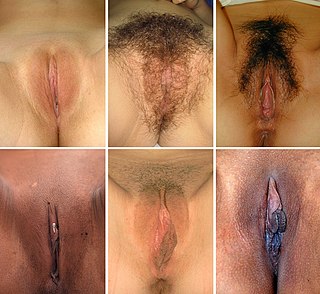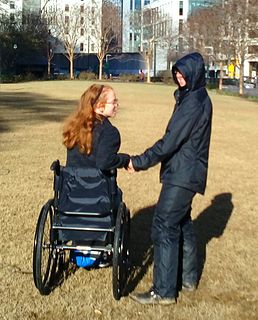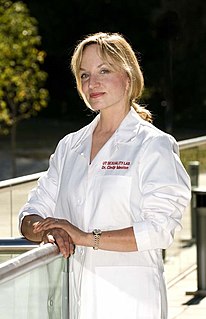
Orgasm is the sudden discharge of accumulated sexual excitement during the sexual response cycle, resulting in rhythmic muscular contractions in the pelvic region characterized by sexual pleasure. Experienced by males and females, orgasms are controlled by the involuntary or autonomic nervous system. They are usually associated with involuntary actions, including muscular spasms in multiple areas of the body, a general euphoric sensation and, frequently, body movements and vocalizations. The period after orgasm is typically a relaxing experience, attributed to the release of the neurohormones oxytocin and prolactin as well as endorphins.
Vulvodynia is a chronic pain syndrome that affects the vulvar area and occurs without an identifiable cause. Symptoms typically include a feeling of burning or irritation. It has been established by the ISSVD that for the diagnosis to be made symptoms must last at least three months.
Sexual desire is an emotion and motivational state characterized by an interest in sexual objects or activities, or by a drive to seek out sexual objects or to engage in sexual activities. It is an aspect of sexuality, which varies significantly from one person to another and also fluctuates depending on circumstances.
The Masters and Johnson research team, composed of William H. Masters and Virginia E. Johnson, pioneered research into the nature of human sexual response and the diagnosis and treatment of sexual disorders and dysfunctions from 1957 until the 1990s.
Anorgasmia is a type of sexual dysfunction in which a person cannot achieve orgasm despite adequate stimulation. Anorgasmia is far more common in females than in males and is especially rare in younger men. The problem is greater in women who are post-menopausal. In males, it is most closely associated with delayed ejaculation. Anorgasmia can often cause sexual frustration.
Dyspareunia is painful sexual intercourse due to medical or psychological causes. The term dyspareunia covers both female dyspareunia and male dyspareunia, but many discussions that use the term without further specification concern the female type, which is more common than the male type. In females, the pain can primarily be on the external surface of the genitalia, or deeper in the pelvis upon deep pressure against the cervix. Medically, dyspareunia is a pelvic floor dysfunction and is frequently underdiagnosed. It can affect a small portion of the vulva or vagina or be felt all over the surface. Understanding the duration, location, and nature of the pain is important in identifying the causes of the pain.
Persistent genital arousal disorder (PGAD), previously called persistent sexual arousal syndrome, is spontaneous, persistent, unwanted and uncontrollable genital arousal in the absence of sexual stimulation or sexual desire, and is typically not relieved by orgasm. Instead, multiple orgasms over hours or days may be required for relief.
Hypoactive sexual desire disorder (HSDD), hyposexuality or inhibited sexual desire (ISD) is sometimes considered a sexual dysfunction, and is characterized as a lack or absence of sexual fantasies and desire for sexual activity, as judged by a clinician. For this to be regarded as a disorder, it must cause marked distress or interpersonal difficulties and not be better accounted for by another mental disorder, a drug, or some other medical condition. A person with ISD will not start, or respond to their partner's desire for, sexual activity. HSDD affects approximately 10% of all pre-menopausal women in the United States, or about 6 million women.
Sexual dysfunction is difficulty experienced by an individual or partners during any stage of normal sexual activity, including physical pleasure, desire, preference, arousal, or orgasm. The World Health Organization defines sexual dysfunction as a "person's inability to participate in a sexual relationship as they would wish". This definition is broad and is subject to many interpretations. A diagnosis of sexual dysfunction under the DSM-5 requires a person to feel extreme distress and interpersonal strain for a minimum of six months. Sexual dysfunction can have a profound impact on an individual's perceived quality of sexual life. The term sexual disorder may not only refer to physical sexual dysfunction, but to paraphilias as well; this is sometimes termed disorder of sexual preference.
The human sexual response cycle is a four-stage model of physiological responses to sexual stimulation, which, in order of their occurrence, are the excitement, plateau, orgasmic, and resolution phases. This physiological response model was first formulated by William H. Masters and Virginia E. Johnson, in their 1966 book Human Sexual Response. Since that time, other models regarding human sexual response have been formulated by several scholars who have criticized certain inaccuracies in the human sexual response cycle model.
Sexual arousal disorder is characterized by a lack or absence of sexual fantasies and desire for sexual activity in a situation that would normally produce sexual arousal, or the inability to attain or maintain typical responses to sexual arousal. The disorder is found in the DSM-IV. The condition should not be confused with a sexual desire disorder.
Sexual medicine or Psychosexual medicine as defined by Masters and Johnsons in their classic Textbook of Sexual Medicine, is “that branch of medicine that focuses on the evaluation and treatment of sexual disorders, which have a high prevalence rate." Examples of disorders treated with sexual medicine are erectile dysfunction, hypogonadism, and prostate cancer. Sexual medicine often uses a multidisciplinary approach involving physicians, mental health professionals, social workers, and sex therapists. Sexual medicine physicians often approach treatment with medicine and surgery, while sex therapists often focus on behavioral treatments.
Female sexual arousal disorder (FSAD) is a disorder characterized by a persistent or recurrent inability to attain sexual arousal or to maintain arousal until the completion of a sexual activity. The diagnosis can also refer to an inadequate lubrication-swelling response normally present during arousal and sexual activity. The condition should be distinguished from a general loss of interest in sexual activity and from other sexual dysfunctions, such as the orgasmic disorder (anorgasmia) and hypoactive sexual desire disorder, which is characterized as a lack or absence of sexual fantasies and desire for sexual activity for some period of time.
Delayed ejaculation (DE) describes a man's inability or persistent difficulty in achieving orgasm, despite typical sexual desire and sexual stimulation. Generally, a man can reach orgasm within a few minutes of active thrusting during sexual intercourse, whereas a man with delayed ejaculation either does not have orgasms at all or cannot have an orgasm until after prolonged intercourse which might last for 30–45 minutes or more. Delayed ejaculation is closely related to anorgasmia.
Robert Taylor Segraves is an American psychiatrist best known for his work on sexual dysfunction and its pharmacologic causes and treatments.

The vulva consists of the external female sex organs. The vulva includes the mons pubis, labia majora, labia minora, clitoris, vestibular bulbs, vulval vestibule, urinary meatus, the vaginal opening, hymen, and Bartholin's and Skene's vestibular glands. The urinary meatus is also included as it opens into the vulval vestibule. Other features of the vulva include the pudendal cleft, sebaceous glands, the urogenital triangle, and pubic hair. The vulva includes the entrance to the vagina, which leads to the uterus, and provides a double layer of protection for this by the folds of the outer and inner labia. Pelvic floor muscles support the structures of the vulva. Other muscles of the urogenital triangle also give support.
Joseph LoPiccolo is an American psychologist and sex researcher who focuses on female sexual response. He coauthored the self-help book Becoming Orgasmic with Julia Heiman and served on the Subcommittee on Sexual Dysfunctions for the DSM-III-R. He is Professor Emeritus of Psychological Sciences at the University of Missouri in Columbia, Missouri, where previously served as Chair of the department.

Sexual arousal describes the physiological and psychological responses in preparation for sexual intercourse or when exposed to sexual stimuli. A number of physiological responses occur in the body and mind as preparation for sexual intercourse, and continue during intercourse. Male arousal will lead to an erection, and in female arousal the body's response is engorged sexual tissues such as nipples, vulva, clitoris, vaginal walls, and vaginal lubrication. Mental stimuli and physical stimuli such as touch, and the internal fluctuation of hormones, can influence sexual arousal.

Although spinal cord injury (SCI) often causes sexual dysfunction, many people with SCI are able to have satisfying sex lives. Physical limitations acquired from SCI affect sexual function and sexuality in broader areas, which in turn has important effects on quality of life. Damage to the spinal cord impairs its ability to transmit messages between the brain and parts of the body below the level of the lesion. This results in lost or reduced sensation and muscle motion, and affects orgasm, erection, ejaculation, and vaginal lubrication. More indirect causes of sexual dysfunction include pain, weakness, and side effects of medications. Psycho-social causes include depression and altered self-image. Many people with SCI have satisfying sex lives, and many experience sexual arousal and orgasm. People with SCI may employ a variety of adaptations to help carry on their sex lives healthily, by focusing on different areas of the body and types of sexual acts. Neural plasticity may account for increases in sensitivity in parts of the body that have not lost sensation, so people often find newly sensitive erotic areas of the skin in erogenous zones or near borders between areas of preserved and lost sensation.

Cindy Meston is a Canadian-American clinical psychologist well-known for her research on the psychophysiology of female sexual arousal. She is a Full Professor of Clinical Psychology at the University of Texas at Austin, Director of the Female Sexual Psychophysiology Laboratory, and author of Why Women Have Sex. In 2016, the BBC, London, England named Meston one of the 100 most influential and inspirational women in the world.





